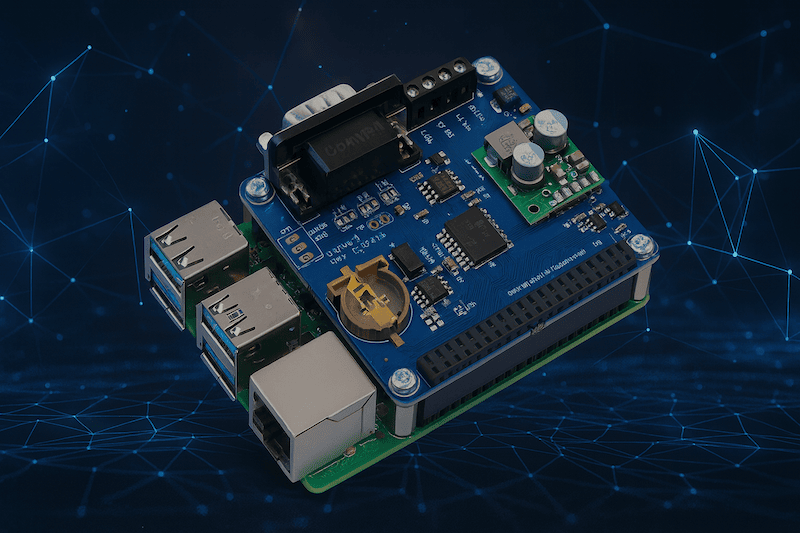Recent Posts
IoT Meets CAN: Building Cloud-Connected Fleet Monitoring with Raspberry Pi + PiCAN3
Posted by on
 The Internet of Things (IoT) is reshaping how vehicles and industrial equipment are monitored and maintained. At the heart of this transformation lies the ability to connect embedded systems—such as those using the CAN Bus protocol—to the cloud. By linking CAN data to online dashboards and analytics tools, fleet operators gain real-time insights into vehicle performance, maintenance needs, and overall efficiency.
The Internet of Things (IoT) is reshaping how vehicles and industrial equipment are monitored and maintained. At the heart of this transformation lies the ability to connect embedded systems—such as those using the CAN Bus protocol—to the cloud. By linking CAN data to online dashboards and analytics tools, fleet operators gain real-time insights into vehicle performance, maintenance needs, and overall efficiency.
One of the most accessible ways to achieve this integration is by combining a Raspberry Pi single-board computer with a PiCAN3 interface board. Together, they form a powerful, compact platform capable of capturing CAN data, processing it locally, and transmitting it to cloud services.
Why CAN Bus Data Matters for Fleet Monitoring
The Controller Area Network (CAN) protocol is the backbone of modern automotive and industrial communication. Vehicles use it extensively to transmit critical information such as engine RPM, fuel consumption, diagnostic trouble codes, and sensor readings.
For fleet operators, tapping into this data unlocks several benefits:
-
Preventive maintenance: Early detection of faults through real-time alerts.
-
Fuel efficiency tracking: Monitoring consumption trends across vehicles.
-
Driver behavior analysis: Capturing acceleration, braking, and idling data.
-
Asset utilization: Ensuring vehicles are used efficiently and downtime is minimized.
Connecting this stream of CAN messages to the cloud makes it possible to track the health of an entire fleet, regardless of location.
The Raspberry Pi + PiCAN3 Solution
The Raspberry Pi is an affordable, Linux-based computer that is widely supported by developers and hobbyists. The PiCAN3 is an add-on board designed specifically to give the Raspberry Pi direct access to CAN Bus networks.
Key features of the PiCAN3 include:
-
Support for CAN 2.0B at speeds up to 1 Mbps.
-
Onboard CAN controller and transceiver, ensuring reliable data capture.
-
SocketCAN compatibility, allowing developers to use standard Linux CAN utilities and programming libraries.
-
Optional GPS, which makes it possible to correlate CAN data with location information.
This hardware pairing creates a flexible gateway capable of capturing, processing, and forwarding vehicle data without requiring specialized hardware beyond the Pi and the PiCAN3 board.
Capturing and Processing CAN Data
Once installed, the PiCAN3 enables the Raspberry Pi to receive messages directly from the vehicle’s CAN network. Developers can use Linux command-line tools like candump to capture raw traffic, or write custom applications in Python, C, or C++ to filter and interpret the data.
Common processing tasks include:
-
Filtering: Selecting only the CAN identifiers relevant to fleet monitoring.
-
Decoding: Translating raw data bytes into human-readable values such as temperature, RPM, or voltage.
-
Aggregation: Summarizing data over time to reduce transmission overhead.
By preprocessing data on the Raspberry Pi, only meaningful information is sent to the cloud, minimizing bandwidth usage and costs.
Cloud Integration and Data Transmission
With CAN data captured and processed, the next step is transmitting it to cloud services. The Raspberry Pi’s built-in Ethernet and Wi-Fi capabilities make it straightforward to connect to the internet. Developers can use lightweight IoT protocols such as MQTT or HTTP REST to deliver data securely to cloud platforms.
A typical setup involves:
-
Local broker or client software on the Raspberry Pi to publish data.
-
Cloud IoT service (e.g., AWS IoT, Azure IoT Hub, or a custom server) that receives, stores, and processes incoming messages.
-
Visualization dashboards built using platforms like Grafana or Power BI to provide operators with real-time insights into vehicle performance.
Security is essential at this stage. Implementing TLS encryption and using secure authentication mechanisms ensures that sensitive fleet data is protected during transmission.
Adding GPS for Location-Aware Monitoring
The PiCAN3’s optional GPS extension elevates the solution from a diagnostic tool to a full fleet management system. By associating CAN metrics with latitude and longitude, operators can track not only how a vehicle is performing but also where it is at any given time.
Examples of GPS-enabled insights include:
-
Geofencing alerts when vehicles enter or leave designated areas.
-
Route efficiency analysis based on fuel consumption and speed patterns.
-
Theft prevention and rapid recovery by providing real-time location tracking.
This combination of performance data and geospatial information gives operators a holistic view of their assets.
Real-World Applications
The Raspberry Pi + PiCAN3 solution has practical applications across industries:
-
Commercial fleets: Monitor trucks, vans, or buses for efficiency and compliance.
-
Agriculture: Collect engine and equipment data from tractors and harvesters in the field.
-
Marine: Track vessel performance and position over NMEA 2000 networks.
-
Research and prototyping: Universities and labs can use the setup to quickly prototype IoT-enabled vehicle systems.
Because the hardware is cost-effective and based on open-source software, it is particularly attractive for small to mid-sized operators and developers looking to innovate without heavy upfront investment.
Environmental Considerations
While the Raspberry Pi and PiCAN3 make an excellent combination for prototyping and real-world fleet monitoring, it is important to recognize their environmental limitations. Both devices are specified for an operating temperature range of 0°C to 50°C (32°F to 122°F). In many industrial applications, this is not a major concern, since control cabinets, server rooms, or equipment enclosures are typically climate-controlled and vibration-isolated.
However, when deployed in automobiles, trucks, boats, or other mobile environments, outside conditions may be far more demanding. Vehicles regularly experience temperature extremes well below freezing and above 50°C, as well as humidity, condensation, and wide thermal fluctuations. Additionally, these environments often involve vibration, shocks, and occasional exposure to dust, dirt, or water—none of which the Raspberry Pi or PiCAN3 are designed to withstand in their bare form.
For this reason, automotive or marine installations should always mount the system inside a rugged, sealed enclosure with adequate environmental protection. This includes weatherproof housings, vibration-damping mounts, and consideration for airflow or passive cooling where heat buildup is possible. By mitigating these environmental risks, the Raspberry Pi + PiCAN3 setup can remain a reliable platform even in harsh mobile conditions.
Power Supply Considerations
The PiCAN3 is designed with an onboard switch-mode power supply (SMPS), allowing it to accept an input voltage in the range of 6 VDC to 20 VDC. This flexibility covers a wide variety of use cases, including direct connection to most automotive, industrial, and marine power systems that operate on 12 VDC or 24 VDC (with proper regulation). However, it is important to ensure that the supply voltage does not exceed the 20 VDC maximum. If the existing power source delivers more than 20 VDC—such as certain heavy-duty vehicle or industrial systems—it is strongly recommended to use an external DC/DC converter to step the voltage down into the acceptable range. Alternatively, if available, an external regulated power supply can be employed. This precaution ensures safe operation, protects the hardware from overvoltage damage, and provides long-term reliability for the entire monitoring setup.
Conclusion
Fleet monitoring is no longer limited to large enterprises with expensive telematics systems. By combining a Raspberry Pi with the PiCAN3 interface, anyone can build a cloud-connected monitoring solution that is affordable, customizable, and scalable. This setup empowers organizations to leverage CAN data in real time, improving operational efficiency, safety, and maintenance planning.
As IoT adoption grows, the marriage of CAN Bus and cloud computing will only become more vital. The Raspberry Pi + PiCAN3 solution provides a practical gateway into this new era of connected fleet management.
References
- Copperhill Technologies – PiCAN3 CAN Bus Board for Raspberry Pi
- Copperhill Technologies – CAN Bus Development with Raspberry Pi vs. Arduino Due
- Copperhill Technologies – Combining CAN Bus and Microcontroller Power: The CANPico V2
Dive into embedded development with Python: Embedded Systems for Beginners, the definitive guide that takes you from your first blinking LED to building intelligent, networked devices and autonomous robots. Whether you’re a hobbyist curious about microcontrollers or a professional engineer looking for rapid prototyping workflows, this comprehensive volume delivers the knowledge and tools you need.
Through a hands-on, project-driven journey, you’ll learn how to:
-
Master MicroPython and CircuitPython on boards like ESP32, Raspberry Pi Pico, and Adafruit’s Circuit Playground—install firmware, explore the REPL, and manage filesystems with ease.
-
Control hardware at the pin level: blink LEDs, read switches, drive motors with PWM, and capture analog sensor data through ADC.
-
Interface with I²C and SPI peripherals: connect to sensors, OLED displays, and ADC/DAC chips using real-world code examples.
-
Bring devices online: configure Wi-Fi on ESP32/ESP8266, publish sensor data via MQTT or HTTP, and integrate with platforms like AWS IoT and Adafruit IO.
-
Design simple robots: control DC, servo, and stepper motors, integrate ultrasonic and line-following sensors, and implement obstacle avoidance entirely in Python.
-
Optimize for performance and power: use sleep modes, manage memory with garbage-collection strategies, and extend Python with native C modules or MicroPython’s Viper for time-critical tasks.
-
Deploy and maintain at scale: autorun scripts on boot, implement over-the-air updates, secure your devices, and manage fleets of embedded systems.
With 24 detailed chapters packed with clear explanations, wiring diagrams, and tested code, this book stays platform-agnostic so you can apply its lessons to any MicroPython-compatible board or Raspberry Pi. By leveraging Python’s readability and ecosystem, you’ll iterate faster, debug interactively, and focus on solving real-world problems—without the steep learning curve of C/C++.
By the end, you’ll have mastered both the theory and practice of Python-powered embedded systems, ready to create smart sensors, home automation tools, industrial controllers, and robots with confidence. Python: Embedded Systems for Beginners is the ultimate roadmap for makers, students, and professionals who want to bring dynamic, connected hardware projects to life. More information...
 Loading... Please wait...
Loading... Please wait...

